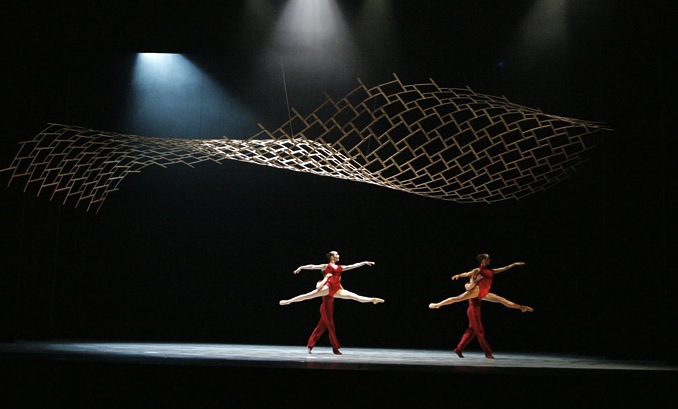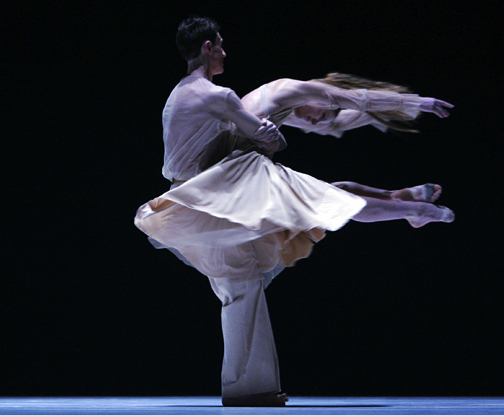Royal New Zealand Ballet, From Here to There, Barbican Theatre | reviews, news & interviews
Royal New Zealand Ballet, From Here to There, Barbican Theatre
Royal New Zealand Ballet, From Here to There, Barbican Theatre
A fine talent among their ranks is one of several plus-points for the Kiwi dancers
All ballet companies dream of finding a genuine creative talent among their ranks, and the Royal New Zealand Ballet, visiting from the farthest end of the world ballet map, have one in Andrew Simmons. The unknown name on their triple bill on this rare visit to London shows a young mind drawn naturally to grace and understated expressiveness.
His creation, A Song in the Dark, is effortlessly better than the busy, inconsequential work by Jorma Elo, one of the most noised names in ballet at the moment, for reasons that escape my understanding. Both pieces are leotard ballets, Elo’s in red, Simmons’s in green, and both have a defining design element - over the dancers in the Elo is suspended a very lovely wave of steel trellis which casts trellised shadows, while beside the dancers in the Simmons is a white angled wall, which reflects their shadows to more emotive effect. Both use contemplative music, Elo plumping for the Baroque Bohemian Heinrich Biber, Simmons for Philip Glass.

Pictured above, Elo's Plan to A, below, De Frutos's Banderillero © Maarten Holl/Barbican
But there meaningful comparison ends. In Plan to A Elo puts the music through some sort of electronic enhancement and strings step after step together seamlessly, its four men and three women organised in sharp, tight little pairs or one-against-threes. They are neat-enough formations and fluent-enough spins and supported jumps, and there's no shortage of steps for the dancers to do, but one doesn't feel that these pieces of movement had to come into being, for this moment, this theatrical happening. They emit few images, pluck no tension with the music, pose no conflict of public and private in the performers’ communication with us, the audience. There are some decidedly unusual grips here and there - the men have a way of grabbing a girl and dragging her by her armpit, or her inner thigh, both of which look painful and yet puzzlingly lacking in any questions, let alone answers.
Whereas Simmons makes a charged atmosphere through filling simple, graceful moves with spacious shape and depth, moving from a solo dancer to 16 of them, the spotlights in the darkness adorning them with translucent shadows on the wall. Here are clean, suggestive phrases of adagio plastique, their clarity cutting through the charged sobs of Philip Glass’s music - part of the Tirol piano concerto and a cello work. The dance is written with the lyrical aloofness of ballet, rather than itchy-twitchy discoordination. But a vast over-supply of Glass’s depressively repetitious arpeggios and chordal throbs means that the choreography thins out fast towards the end. Cut shorter, and with the female dancers asked not to feel obliged to hit an assertive 6 o’clock arabesque when a more tilted, swaying 10-to-six would be more evocative, this would be a piece fit to travel to other companies. Well done, him and them.
 All the same, when we come to Javier De Frutos’s Banderillero, this is a higher plane of expertise altogether. If De Frutos’s work with the Pet Shop Boys, The Most Incredible Thing, was choreographically weak in the face of all its determination to entertain the masses, this shows just what the Venezuelan Londoner can fashion in dance at his best.
All the same, when we come to Javier De Frutos’s Banderillero, this is a higher plane of expertise altogether. If De Frutos’s work with the Pet Shop Boys, The Most Incredible Thing, was choreographically weak in the face of all its determination to entertain the masses, this shows just what the Venezuelan Londoner can fashion in dance at his best.
A piquant layering of voluptuously Latin-flavoured dances over arresting Chinese drum and gong music from percussionist Yim Hok-Man, the clash works because of the unity with which it’s made theatre. De Frutos designed the clothes too, floaty white long dresses and trousers, hair untied and flying, everything chiffony and irregular, as if evaporating. An arena of light fills the centre of the stage, leaving uncertain darkness all around.
The dancers step in and out of the ring as if it's a flamenco challenge, tension screwed tight by the sudden alerts of the percussion, the fighter teasing the animal, but also declaring little momentary narratives of desire, anger, confrontation - with the wrong people stealing kisses from each other, secrets being hinted at. It’s the fiery women who are more like attacking matadors than the men, who switch between group macho drills and wry camp little sideshows as if ducking out of the fight.
Florid arms with strongly gesturing hands are such a joy to see in contemporary choreography (where so often they’re schooled to sterile mittens), and so are flying ballet jetés and feline wriggles in the back. It’s a gumbo, is De Frutos’s choreography, and when cooked with this much skill and care, it’s outstandingly tasty stuff. This is the second of two admirable pieces he's made for New Zealand, the other being his stunning Milagros (2003), one of his settings of The Rite of Spring.
As for the company, under the temporary directorship of Matz Skoog, formerly ENB’s director, and the imminent new director, one of New York’s recent ballet divinities, Ethan Stiefel, the New Zealanders look well placed to impress the world on their travels.
- Royal New Zealand Ballet perform at the Barbican Theatre, London, till tomorrow, then Nottingham Playhouse on 19 July and Bradford, The Alhambra on 20 July
 Find Yim Hok-Man's Poems of Thunder on Amazon (the music for Banderillero)
Find Yim Hok-Man's Poems of Thunder on Amazon (the music for Banderillero) Find Philip Glass's Songs and Poems for Solo Cello on Amazon (the music for A Song in the Dark)
Find Philip Glass's Songs and Poems for Solo Cello on Amazon (the music for A Song in the Dark)- Read theartsdesk Q&A with Javier de Frutos
- See what's on at the Barbican Centre. Read Barbican reviews
Watch Andrew Simmons working on creating A Song in the Dark with RNZB
Share this article
more Dance
 All You Need Is Death review - a future folk horror classic
Irish folkies seek a cursed ancient song in Paul Duane's impressive fiction debut
All You Need Is Death review - a future folk horror classic
Irish folkies seek a cursed ancient song in Paul Duane's impressive fiction debut
 MacMillan Celebrated, Royal Ballet review - out of mothballs, three vintage works to marvel at
Less-known pieces spanning the career of a great choreographer underline his greatness
MacMillan Celebrated, Royal Ballet review - out of mothballs, three vintage works to marvel at
Less-known pieces spanning the career of a great choreographer underline his greatness
 Carmen, English National Ballet review - lots of energy, even violence, but nothing new to say
Johan Inger's take on Carmen tries but fails to make a point about male violence
Carmen, English National Ballet review - lots of energy, even violence, but nothing new to say
Johan Inger's take on Carmen tries but fails to make a point about male violence
 WAKE, National Stadium, Dublin review - a rainbow river of dance, song, and so much else
THISISPOPBABY serves up a joyous tapestry of Ireland contemporary and traditional
WAKE, National Stadium, Dublin review - a rainbow river of dance, song, and so much else
THISISPOPBABY serves up a joyous tapestry of Ireland contemporary and traditional
 Swan Lake, Royal Ballet review - grand, eloquent, superb
Liam Scarlett's fine refashioning returns for a third season, and looks better than ever
Swan Lake, Royal Ballet review - grand, eloquent, superb
Liam Scarlett's fine refashioning returns for a third season, and looks better than ever
 First Person: Ten Years On - Flamenco guitarist Paco Peña pays tribute to his friend, the late, great Paco de Lucía
On the 10th anniversary of his death, memories of the prodigious musician who broadened the reach of flamenco into jazz and beyond
First Person: Ten Years On - Flamenco guitarist Paco Peña pays tribute to his friend, the late, great Paco de Lucía
On the 10th anniversary of his death, memories of the prodigious musician who broadened the reach of flamenco into jazz and beyond
 Dance for Ukraine Gala, London Palladium review - a second rich helping of international dancers
Ivan Putrov's latest gala was a satisfying mix of stars and young hopefuls
Dance for Ukraine Gala, London Palladium review - a second rich helping of international dancers
Ivan Putrov's latest gala was a satisfying mix of stars and young hopefuls
 Nelken: A Piece by Pina Bausch, Sadler's Wells review - welcome return for an indelible classic
A new generation of gifted performers for us to get to know
Nelken: A Piece by Pina Bausch, Sadler's Wells review - welcome return for an indelible classic
A new generation of gifted performers for us to get to know
 Dark With Excessive Bright, Royal Ballet review - a close encounter with dancers stripped bare
The Royal's Festival of New Choreography launches with an unforgettable walk in the dark
Dark With Excessive Bright, Royal Ballet review - a close encounter with dancers stripped bare
The Royal's Festival of New Choreography launches with an unforgettable walk in the dark
 La Strada, Sadler's Wells review - a long and bumpy road
Even the exceptional talents of Alina Cojocaru can't save dance adaptation of Fellini film
La Strada, Sadler's Wells review - a long and bumpy road
Even the exceptional talents of Alina Cojocaru can't save dance adaptation of Fellini film
 First Person: pioneering juggler Sean Gandini reflects on how the spirit of Pina Bausch has infiltrated his work
As Tanztheater Wuppertal Pina Bausch's 'Nelken' comes to Sadler’s Wells, a tribute from across the art forms
First Person: pioneering juggler Sean Gandini reflects on how the spirit of Pina Bausch has infiltrated his work
As Tanztheater Wuppertal Pina Bausch's 'Nelken' comes to Sadler’s Wells, a tribute from across the art forms
 Manon, Royal Ballet review - a glorious half-century revival of a modern classic
Fifty years on, Kenneth MacMillan's crash-and-burn anti-heroine is riding high
Manon, Royal Ballet review - a glorious half-century revival of a modern classic
Fifty years on, Kenneth MacMillan's crash-and-burn anti-heroine is riding high

Add comment